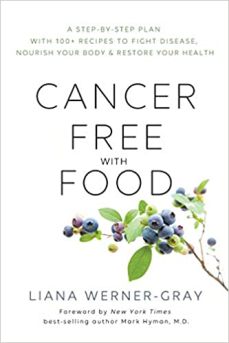
Cancer-Free with Food – Liana Werner-Gray
(Buy from Amazon; Buy from The Book Depository)
The best-selling author of The Earth Diet offers a simple yet comprehensive guide to nutrition for those who have been diagnosed with cancer. With a foreword by Mark Hyman, M.D.
If you want to fight cancer, what should you eat?
Food is medicine. By now, this important message has made its way from holistic circles to the mainstream. To ward off cancer and decrease its risk, meals specially formulated to nourish, soothe, and fortify can be an important part of treatment. But what foods work best? That remains frustratingly elusive and time-consuming to research.
Happily, author Liana Werner-Gray–known for her best-selling books including The Earth Diet and 10-Minute Recipes–has done the research for you. Within these pages she has gathered the best foods for various types of cancer, along with 195 simple and tested recipes created to boost your immune system and promote healing. Designed to work on their own or in conjunction with other therapies, these healthy and appealing meals can also be tailored for a gluten-free, keto, vegan, and paleo diet.
* For skin cancers, try Walnut “Meatballs” (page 210)
* For lung cancer, try Cauliflower Popcorn (page 223)
* For breast cancers, try an Orange Arugula Avocado Sesame Seed Salad (page 249)
* For prostate cancer, try Vanilla Pudding (page 335)
* For liver cancer, try Bentonite Clay Drink (page 193)
“An extraordinarily relevant book . . . Cancer-Free with Food is medicine for the 21st century.”
— Mark Hyman, M.D., director, Cleveland Clinic Center for Functional Medicine.
“In Cancer-Free with Food, Liana shows how to turn your kitchen into a pharmacy so that you can take care of your health at the most fundamental and important level.”
— Ty M. Bollinger, New York Times best-selling author of The Truth About Cancer
“An essential guide for anyone diagnosed with cancer.”
— Josh Axe DNM, DC, CNS, certified doctor of natural medicine, doctor of chiropractic and clinical nutritionist, and author of Eat Dirt
“Cancer-Free with Food is a guidebook for anyone looking to heal their body from the inside out.”
— Vani Hari, New York Times best-selling author of The Food Babe Way
Disclaimer: This page contains affiliate links that may provide monetary compensation to help support the Whole Guidance Vision of Creating a Happy and Healthy Planet should you make a purchase. We very much appreciate and thank you for your support.
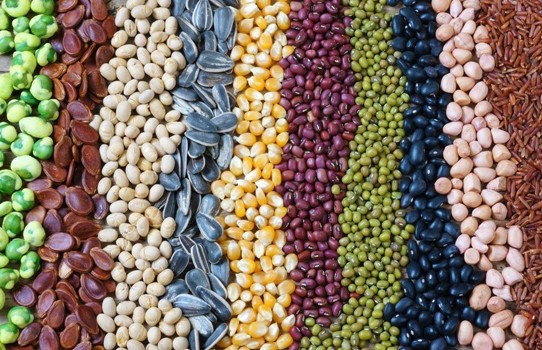
Podcast: Play in new window | Download
In this podcast I’ll be exploring Food Anti-Nutrients:
- I’ll explain what anti-nutrients are
- I’ll talk about how anti-nutrients affect your body and how they affect the absorption of other nutrients
- I’ll list foods that are thought to be extremely nutritious, but really are extremely anti-nutritious
- Finally, I’ll share how to best prepare foods to lower their anti-nutrient content
CLICK HERE TO LEARN WHAT ARE THE BEST FOODS TO GET YOU LEAN
Everyone knows what a nutrient is – a substance that nourishes the mind, body, and soul. But have you heard of anti-nutrients? Anti-nutrients are plant compounds that prevent you, the plant predator, from stealing or absorbing nutrients from the plant.
Believe it or not plants and other living creatures were not put on this planet for the sole purpose of feeding the human race. Plants are sentient life forms, like you and me. They have their own life purpose with the dream of the continuation of their own species and since they don’t have legs to run away or claws to fight off predators they use chemicals to protect themselves. By using biological phytochemical warfare in the form of these anti-nutrients plants increase the chances of their own survival and the survival of their offspring. While at the same time causing a lot of health issues for their predators. So anti-nutrients are a plants innate defence mechanism. These anti-nutrients can negatively affect your health.
Examples of anti-nutrients used by plants include:
- Lectins
- Saponins
- Gluten
- Phytic acid or phytates and
- Enzyme inhibitors
Lectins have been shown to bind to insulin receptors on the walls of your cells. Insulin is the hormone responsible for putting nutrients into your cells and if you’ve had a carb rich meal high in lectins then all that sugar that’s now flowing in your bloodstream cannot be absorbed into your cells because lectin is blocking insulin from attaching to the cell. When sugar is blocked from getting into your cells it’s left to roam in your bloodstream and when it lingers there for far too long this causes damage and inflammation to your cells. Think of your arteries, think of your brain neurons, think of any part of your body where sugar attaches itself to the cells, it becomes glycated, glued to the cell and it causes malfunction and damage. We’ve all heard of diabetes and this is what happens when sugar is left to linger in your bloodstream.
Gluten, saponins and lectins can also cause irritation to your gut, to your intestines. Remember your gut is where most of your nutrient absorption takes place, but if your gut is stressed, inflamed, or compromised then you don’t absorb as much nutrition as you should. Your gut wall is like a net, like a mosquito net where it keeps the pesky bugs out, while letting the proper nutrients in. The problem is lectins, saponins and gluten they’re like mosquitos with little katana blades that cut through the net creating tiny little holes that allow them and other molecules such as undigested food particles and disease causing microorganisms, pathogens, to get into your body.
When you get undigested and unprocessed food particles, pathogens, and other foreign materials in your bloodstream your body mounts an immune response and this leads to inflammation and stress. Now if this stress is chronic and goes on for a long time, if your body has to fight off these pathogens and foreign material that shouldn’t be there day after day because your gut has become leaky this is how you get really sick and get diagnosed with autoimmune conditions like rheumatoid arthritis, lupus, Hashimoto’s, psoriasis, diabetes, and coeliac disease, just to name a few.
When it comes to phytic acid this will bind to minerals meaning that if a food is high in say zinc like pumpkin seeds, but that food is also high in phytic acid then when you eat pumpkin seeds for example you only absorb a small amount of zinc or a small amount of that mineral. This is due to most of the mineral being bound to the phytic acid creating a phytate molecule. So it doesn’t matter the nutrient content of a food if it has high phytic acid content, because that high phytic acid will reduce the amount of minerals you actually get to absorb.
Enzyme inhibitors are substances that stop digestive enzymes from doing their job of breaking down the food you eat. In the case of a trypsin inhibitor it is a protease inhibitor meaning it prevents the breakdown of protein. So if you were to eat a nice chicken salad with green leafy vegetables and pumpkin seeds you may be thinking you’re getting a lot of protein from the chicken and vitamins and minerals from the vegetables. But the trypsin inhibitors and phytates that come from the plant foods will actually bind up a lot of those minerals and they will prevent you from fully digesting and breaking down that protein. Plus the saponins, lectins, and gluten, if it had croutons in the salad, will be tearing up your gut making even less nutrition available for absorption while allowing bad stuff to get directly into your bloodstream. You are getting less nutrition than you think because of these anti-nutrients.
But can you blame plants for these anti-nutrients? If I was a plant I’d make sure predators suffered the consequences too.
I’ll list the main types of foods that are full of nutrients so are thought to be very nutritious and good for you, but actually are also jammed packed and full of anti-nutrients and so turn out to be not that healthy at all. This includes:
- Grains (both gluten-free like rice and corn and gluten containing grains)
- Legumes (beans including soy and peanuts)
- Nuts and
- Seeds
What do all of these have in common, these 4 food groups? Technically these are all seeds of plants. They are the next generation and they will not go down without a fight hence the high anti-nutrient content of these foods. Yes you can still find anti-nutrients in whole vegetables and fruits, but seeds have the highest amounts.
It is true that seeds are full of nutrients and they need to be because within this one seed is an entire plant, but these nutrients are not highly available or absorbable, another way to say it is bioavailable due to the high anti-nutrient content. Remember theses seeds need a way to protect themselves. So even though for 100 g of pumpkin seeds you will see 7.5 mg of zinc in the nutrition profile, you may only get 50% or even less of that zinc because it’s bound to the phytic acid in the pumpkin seed. Same with whole grains and legumes which are full of vitamins and minerals. But they’re also full of gluten, saponins, and lectins and a lot of sugar and starch and excessive intake of all of these will cause gut irritation leading to low vitamin and mineral uptake.
So these nutritious seeds turn out to be more unhealthy than healthy and not just because you absorb less, but also because they cause gut inflammation and stress throughout your entire body.
So how do you make the nutrients in these seeds more bioavailable and also reduce the anti-nutrients and the stress and the inflammation they cause? By using ancestral traditional food preparation methods, that’s how. Yes you have to go back in time in order to improve your future.
Our human ancestors through trial and error figured out that by soaking and sprouting and fermenting grains, legumes, nuts, and seeds they could reduce the anti-nutrient content while at the same time increase the bioavailability of other nutrients. Not only that, but soaking and sprouting and fermenting seeds reduces gut stress by making them a lot more digestible and easier on your stomach.
General soaking and fermenting guidelines are to use filtered water with some natural salt or whey depending on what you’re soaking and letting grains and legumes soak or ferment for 12 to 24 hours and nuts and seeds to soak from 4-144 hours. After soaking you can then dehydrate, lightly roast dry, or cook the seeds. Seeds left to soak for a long time will eventually begin to sprout releasing all that stored up nutrition to feed the growing embryo. Each seed (grains, legumes, nuts) has a different preparation method, so I’m not going to explain every single method in this podcast, but I will put a bunch of links to more information on how to soak and sprout seeds and ferment seeds in the blog post for this episode.
A very awesome book about real food nutrition and traditional cooking methods is Nourishing Traditions by Sally Fallon and Mary Enig. Here’s a passage from that book:
“Traditional societies usually soak or ferment their grains before eating them, processes that neutralize phytates and enzyme inhibitors and, in effect, predigest grains so that all their nutrients are more available. Sprouting, overnight soaking and old-fashioned sour leavening can accomplish this important predigestion process in our own kitchen.”
So you can buy sprouted and fermented breads in the store by looking for sprouted or sourdough breads. Nuts and seeds that have been soaked or sprouted are also called activated nuts and seeds, because this process activates the germination process for growth so look for soaked, sprouted, or activated nuts and seeds on labels. Of course the best grains, legumes, nuts and seeds are raw seeds that you’ve activated at home yourself.
Yes anti-nutrients have their bad side, but they do have a few benefits as well. So the goal isn’t to eat an anti-nutrient ever. The goal is to eat more nutrients compared to anti-nutrients and you do this by properly preparing seeds before you eat them.
Here’s to seed activation.
Links and Resources
- SPROUTING VS SOURING VS SOAKING OF GRAINS — CulturesForHealth.com
- YOUR GUIDE TO SOAKING & SPROUTING WHOLE GRAINS, BEANS, NUTS, & SEEDS — WeedEmAndReap.com
- Nourishing Traditions — Sally Fallon and Mary Enig
Please leave a 5-star iTunes review for the Whole Guidance Podcast
Podcast: Play in new window | Download
Subscribe: iTunes | Stitcher Radio | Android | RSS
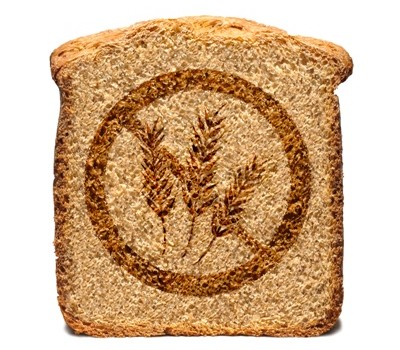
Podcast: Play in new window | Download
In this podcast I’ll be exploring Non-Coeliac Gluten Sensitivity or NCGS and living Free of Gluten:
- I’ll explain what gluten is and how it can negatively impact your health
- I’ll talk about the differences between coeliac disease and non-coeliac gluten sensitivity
- I’ll also talk about the single biggest mistake people make when shifting to a gluten-free diet
- Finally I’ll share some simple and effective tips on how to make gluten-free a part of your lifestyle
CLICK HERE TO LEARN WHAT ARE THE BEST FOODS TO GET YOU LEAN
So what exactly is gluten?
Gluten is a complex protein found in some grains. This includes all wheat varieties such as:
- Spelt
- Einkorn
- Emmer
- Durum and
- Khorasan aka Kamut
And also includes the grains barley and rye.
Oats don’t have the same gluten proteins, but the way that most of the oats are processed and stored today means that they do contain high amounts of gluten simply by being exposed to the same facilities and transport vehicles that are used for gluten-containing grains. So there’s a lot of cross-contamination that occurs with oats.
Gluten is made up of two different proteins gliadin and glutenin. Gliadin gives gluten its gluey stickiness and glutenin gives gluten its flexibility and stretchiness. This is why gluten-containing grains are perfect for baking and for manufacturing pretend fake food-like products. This viscosity and elasticity provides you the consumer with a delectable and delightful eating experience.
The problem with gluten today though is that it isn’t the same gluten our agricultural ancestors ate. The wheat you’re eating today is nowhere near the same wheat that is associated with biblical times commonly referred to as the staff of life.
In the past 60 years man has taken it upon himself to modify wheat into a more versatile and robust crop. Why would we do this? World hunger. There was a time in the mid 20th century where the main focus of society was on starving populations.
How times have changed eh. Today the main focus is on the war on terror or as I call it the submission to fear, but anyhoo… back to gluten.
In order to feed the world scientists and farmers hybridised different wheat varieties resulting in a wheat crop that was more resistant to temperature changes and drought and that would also grow more grains in less time. Specific wheat varieties were also chosen for their increased gluten content making for a better cooking ingredient.
And thus today we have modern wheat which is the third highest produced crop in the world behind corn and rice.
This wheat not only has higher amounts of proteins including gluten, but also has higher amounts of starch and sugar compared to ancient grains. Sure modern wheat has awesome baking characteristics and tastes nice and sweet, but unfortunately more gluten and more sugar make for more fat, more inflammation, more obesity, more diabetes, more heart disease, more cancer… and you get the idea.
So how does gluten contribute to making you fat, sick, and nearly dead? In more ways than one unfortunately.
First gluten damages your gut. You have this protective barrier lining your gut like a giant fortress wall and along the wall every now and then there are little gateways that open and close allowing certain nutrients in. Gluten actually causes these gateways to open allowing anything and everything to slip through into your body. This is known as intestinal hyperpermeability or leaky gut syndrome. When your gut becomes leaky you can get a whole cascade of health problems manifest as a result because now your immune system needs to go on high alert and has to battle all these foreign materials that should not be in your bloodstream. This heightened immune response creates stress and inflammation and chronic stress and chronic inflammation together are the main causes for all chronic degenerative diseases today.
Not only that, but any undigested food particles that leak through into your bloodstream will be targeted by your immune system and then out of nowhere you become sensitive to certain foods, foods that you’ve eaten your whole entire life and eat on a regular basis you will no longer be able to handle. So if a big piece of beef or broccoli or egg gets through a leaky gut the immune system will tag it for elimination and new immune cells are created specifically to get rid of that food molecule.
So let’s say a piece of undigested chicken got through your leaky gut wall. Your immune system sees it in the body and creates an antibody for it. An antibody is like an assassin that shoots to kill only specific targets, and you have many different antibodies each created for different kinds of threats. For example if you’ve ever had measles or chickenpox or had a vaccination for a specific disease your immune system would have created specific antibodies for them. So if you were to ever get measles or chickenpox those antibodies can quickly get to work and kill off the disease.
Coming back to the undigested chicken particles now that your immune system has seen it and created specific antibodies for it, anytime you eat chicken the immune cells, the chicken antibodies, the chicken assassin that has just been hanging around waiting for an excuse to fire off its weapon starts firing away causing inflammation. Your genetic weak link will determine where most of that inflammation and damage will occur so it could be in your skin, your brain, your heart, your muscles, your bones, your joints or even your gut it all depends.
So gluten activates the genes for intestinal hyperpermeability aka leaky gut and a leaky gut causes immune activation, inflammation, and food sensitivities all of which open the door for the development of autoimmune diseases.
Humans cannot fully digest gluten and because of this gluten alone can excite your immune system creating inflammation. Protein molecules like gluten are made up of polypeptides or long chains of amino acids. So as an analogy think of a protein molecule as a pearl necklace and an amino acid as an individual pearl. Through the process of digestion in your mouth, your stomach, and small intestines these pearl necklaces are broken down into single pearls allowing them to be absorbed and assimilated through your protective gut wall.
However, the human digestive system cannot digest and break down gluten into individual pearls. Gluten has a very unique and strange sequence of pearls, of amino acids that your gut enzymes do not recognise. So while your body will break up the long gluten necklace into smaller peptides or into smaller groups of pearls it will never be able to turn gluten into easily digestible single pearls. So just as I said before when you have a leaky gut and these larger chunks of gluten get into your bloodstream they will create havoc and mayhem and inflammation as your immune system becomes activated and goes about its business of wiping them out.
What makes matters worse is that the order of the pearls in the gluten necklaces, the sequence of amino acids that make up these undigested gluten molecules they look very similar to the amino acid sequence of organs and tissues in your body. This is known as molecular mimicry where foreign protein molecules are similar in structure to human tissue. So now your immune system which has created antibodies to these invading gluten proteins gets confused and instead of just taking out the gluten your antibodies, your assassins they begin attacking your gut leading to coeliac or Crohn’s or inflammatory bowel disease preventing you from fully digesting and absorbing the nutrients from the food you eat. Your immune cells will attack your thyroid causing hypothyroidism slowing down your metabolism making you feel slow and tired. Your skin is your largest organ and this can get attacked as well causing a whole range of skin disorders and even your brain tissue gets damaged by your own immune system leading to ataxia, multiple sclerosis, autism, depression, headaches, and giving you a foggy mind. Talk about a case of mistaken identity.
When your immune system reacts to your own body this is called an autoimmune disease.
Gluten can also disrupt the microbiota in your gut causing a reduction in probiotics the good population of microorganisms and an increase in pathogens the bad population. This imbalance is known as dysbiosis. This is due to the toxic chemicals and genetically modified organisms (GMOs) used in the production of gluten-containing grains. These foreign compounds kill off the probiotics and allow the pathogens to thrive. The more bad guys you have in your gut the more immune system activation you will have and the more inflammation your body will experience and the more stress you will have in your life.
One final and fascinating part (well I think its fascinating) to how gluten negatively impacts your health is how it affects your brain.
When your body attempts to break down gluten new pearl necklaces are created, new proteins and one of these new protein molecules is called gluteomorphin. Gluteomorphins activate opioid receptors in your body meaning your brain thinks it’s getting a dose of opium. Usually your body’s own endorphin chemicals stimulate your opioid receptors making you feel good and also reduce your perception to pain. But gluten as well as dairy (in the case of dairy these opioid and morphine-like proteins are called casomorphins) so gluten and dairy stimulate your opioid receptors giving you a bit of a high making you feel super awesome. Any wonder now why people fight tooth and nail when trying to give up bread and milk? It is rare, but some people actually do suffer severe withdrawal symptoms when coming off gluten due to the opioid drug-like effect that these gluteomorphins have on the nervous system.
Okay so if gluten contributes to gut damage, inflammation, and affects your neurology why is it that not everyone is keeling over in abdominal pain or experiencing depression right after eating gluten?
Three reasons: first one is genetics and epigenetics. Maybe you don’t have the genes that make you more easily affected by gluten. Awesome, good for you. That would put you in the estimated 50% of people who have been clinically shown to not be affected by gluten even though it does cause a few gaps in your gut wall.
Now even if you do have the gluten causing inflammatory genes remember epigenetics which is about how your environment and lifestyle determine which genes get switched on and expressed and which genes remain in the off position. So you have the genes, but your environment is helping to keep those genes switched off.
Second reason that people aren’t experiencing obvious gluten reactions is symptomatology. Diseases such as cancer and Alzheimer’s can take many years to manifest and express as a symptom. You could be experiencing hidden chronic stress and hidden chronic inflammation due to the consumption of gluten right now without even knowing it. Of all the people diagnosed with full-blown coeliac disease only around 15% of them express gastrointestinal symptoms, gut symptoms. The rest of people with coeliac express extraintestinal symptoms meaning they have issues in their skin, brain, joints, muscles, bones, anywhere but the gut. So just because you don’t feel the fire due to gluten doesn’t mean it’s not affecting you.
Last reason deals with time and immune tolerance. Some people suffer from an illness right out of the womb at childbirth; whereas it can take 60 years before somebody else will experience that same disease. This is due to your immune system’s ability to respond when needed and when your immune system becomes unresponsive this is known as a loss of immune tolerance. For example it has been shown that some people can go their entire life eating gluten without problem, but once they reached their 70s they developed coeliac disease because their immune system lost the ability to respond to gluten. So while you may not have coeliac disease or sensitivity to gluten now if you have the genes and you’re living an unhealthy lifestyle it is only a matter of time before that small amount of gluten in that delicious caramel slice acts like the proverbial straw that broke the camel’s back leaving you with an upset gut, crappy skin, and bad moods.
Okay so what exactly is coeliac disease?
Coeliac disease is an autoimmune condition where your immune system reacts to gluten attacking your own body causing inflammation and damage to your gut and other tissues in your body. As previously mentioned this can include gut symptoms in about 15% of coeliac patients such as:
- Diarrhoea
- Constipation
- Bloating
- Cramping and
- Vomiting
Most other people with coeliac disease, however, express extraintestinal symptoms such as:
- Excessive weight loss
- Dermatitis herpetiformis and other skin issues
- Iron-deficient anaemia
- Arthritis
- Neurological and psychiatric disorders
- Infertility issues
It’s estimated that about 3% of the population have coeliac disease. If you have a family member diagnosed with coeliac disease than your chance of having coeliac disease jumps to 20%.
Now why do the rest of us have to worry about gluten? Well the fact that no human can fully digest gluten and realising that nothing in life is neither black nor white, but different shades of grey should make you think that even though you may not be on the extreme end of coeliac perhaps you’re somewhere in the middle of that spectrum or if you’re lucky may be you’re on the other extreme end where you tolerate gluten pretty well.
This is where the condition known as Non-Coeliac Gluten Sensitivity or NCGS comes in. NCGS like coeliac disease is where your immune system reacts to gluten causing inflammation and damage to your gut and other tissues in your body. But NCGS is not an autoimmune condition so your immune system isn’t attacking your body, but can become overactive leading to the development of an autoimmune disease later in life. People with NCGS experience the same symptoms as people with coeliac disease plus the following:
- Headaches and migraines
- Obesity
- Fibromyalgia
- Ataxia
- Depression
- Parkinson’s
- Alzheimer’s
- Asperger’s
- Autism
- ADD/ADHD
- Diabetes and
- Hashimoto’s and hypothyroidism
It’s estimated that about 10% of the population has NCGS, but due to the fact that testing for NCGS is still a new field of study with technology just catching up this number isn’t reliable. It has been shown in clinical practice where doctors work with patients that about 30-60% of sick people who change to a gluten-free lifestyle no longer show any signs and symptoms of disease. So it could be said that 1 in 2 people are sensitive to gluten.
Now there are many lab tests that you can pay for and take to find out if you have coeliac disease and if you’re experiencing any of the previously mentioned symptoms this would be a good idea. There are also other lab tests you can take to find out if you have NCGS, but as I said this form of testing is new and cannot be relied on 100%.
The best test for NCGS to find out if you’re sensitive to gluten is one you can do at home. It’s a gluten elimination and challenge test that involves the removal of gluten from your diet for 91 days, that’s 3 months followed by a gluten challenge. If you experience any symptoms after the challenge you’re most likely sensitive to gluten.
Okay so let’s say you do a lab test or the gluten elimination and challenge test and find out you’re gluten sensitive whether it be full-blown coeliac disease or NCGS well now what do you do?
Well whatever you do, DON’T DO THIS! The single biggest mistake that most people make when first switching to a gluten-free diet is to swap out all gluten-containing foods with processed and packaged gluten-free foods thinking they’re living healthier than before.
Processed and packaged foods whether they are gluten-free or not are still fake pretend food-like products lacking nutrition as well as having no energy and screwed up information. Swapping out gluten-containing pasta, cookies, rice crackers, for gluten-free versions does not eliminate the rancid oxidised and damaged industrial seed oils aka vegetables oils and does not eliminate processed and refined sugars and also does not eliminate the chemical additives and preservatives like colourings, thickeners, and MSG. Gluten-free junk food is still junk food. You eat junk, you feel like junk, and you produce junk in your life.
Now the other issue with processed and packaged foods labelled gluten-free is that labelling standards state that any manufactured food with a gluten content of up to 20 parts per million can be legally labelled as gluten-free. Why this number? Because gluten containing foods that are 20 ppm or less have been shown to not cause further gut damage when talking about coeliac disease, but what about damage to your skin, your bones, your heart, and your brain? If you end up eating a lot of these gluten-free foods even in the parts per million you’re still getting a few milligrams of gluten and Dr Aristo Vojdani a world renowned Immunologist says that only 1/1000th of a gram which is 1 milligram is enough to activate your immune system and produce anti-gliadin antibodies or gluten assassins.
So the bottom line is it only takes a little bit of gluten about the size of a kernel of wheat for it to activate your genes for leaky gut, for it to excite your immune system, and for it to produce antibodies that will start killing off both gluten proteins as well as your own body tissue and this goes on for a minimum of 3 months and up to around 6 months.
Dr Rodney Ford a paediatrician, gastroenterologist, and allergist with over 30 years experience uses the term Gluten-Zero which I like. Zero means just that. No gluten whatsoever. Just as you cannot be a little bit pregnant you cannot have just a little bit of gluten. You’re either on the spectrum of gluten sensitivity or not.
Right about now you’re probably thinking to yourself, ‘That sounds like too much work, that’s too hard, how exactly do I go gluten-free?’ and the first and best tip I can give you is to find a why. Find a big enough reason that’s going to surpass any challenges and obstacles that will most definitely come your way. What is your dream when it comes to living a gluten-free lifestyle? By having a dream you will make your health and being gluten-free the priority.
As part of the dream building process you can reframe how you see this new way of being.
Now it probably looks like a lot of work and a big hassle and stress that you just don’t have the time to deal with right now. Perhaps you can change your perspective to one of appreciation. How?
Appreciate the fact that you are like a canary in the coal mine and that you have heightened senses about what makes you feel bad. You are the lucky one. You have an obvious symptom teaching you to change so you won’t get a debilitating disease in the future.
Around 50% of the rest of population will continue to eat gluten without any obvious symptoms or are not mindful and aware enough of their own body language to know it’s talking to them daily and so these asymptomatic folk will eventually present with an illness and a disease later on in their life. The people that don’t know that they are sensitive to gluten will have an increased risk of death and will get colon cancer and Alzheimer’s and skin issues as well as gluten ataxia, congestive heart failure etc. Count yourself lucky that you do know that you’re sensitive to gluten and now that you know better you can do better!
Also please do not label yourself as the disease or condition. You are not a coeliac. You are not sensitive to gluten. Your body has a disease called coeliac disease. Your body has a condition called NCGS. You are not your body just as you are not your big toe, your hair, or your love handles. You have all these things, but are not these things.
As part of the dream building process communicate to all the people in your life who may be affected by and may also affect you in your gluten-free lifestyle. This can include family, friends, workmates, teammates, waiters and managers in restaurants anyone who will have a direct influence on your ability to live gluten-free. Communicate to them let them know what your dream is and what it is you need and how they can support you.
Go back and listen to the podcast I did on dream building to find out how you can better set yourself up for success when switching to a gluten-free way of living.
Next tip is to do the research and become an expert in gluten. Learn what foods contain gluten. Learn how gluten directly affects you and do not trust food labels. Research suspect food products by calling up the manufacturer. Get the word from the horses mouth.
Now is the time to clear out your house of all gluten-containing products. Could be food, personal care products, home care products anything that has gluten in it. You will replace all of these with gluten-free and non-toxic alternatives.
With regards to food you can replace tasteless and nutritionless pasta with delicious nutritious zucchini or courgette or butternut squash or spaghetti squash pasta. Actually any vegetable you can spiralise and peel will do the pasta trick.
For salad dressings make your own with extra-virgin olive oil mixed with some acid like fresh lemon or lime juice or apple cider vinegar.
Instead of wheat-based soy sauces use gluten-free tamari soy sauce or coconut aminos as alternatives.
Want to do some gluten-free baking? Swap out the grain flours for coconut flour, almond flour, linseed or flaxseed meal, and for something a bit more sugary and sweet use a mixture of white rice flour, tapioca flour, and potato starch.
People always complain about not knowing what to have for breakfast when going gluten-free. Try a bowl of chia seeds soaked in a liquid with some nuts to act as a cereal replacement. Why not have the classic free range bacon and eggs or leftovers from dinner? In reality there is no such thing as a breakfast, lunch or dinner food. Real food is nutritious, energising and informative no matter when you eat it. As always though listen to your body and learn what portion sizes and times of the day your body prefers meals.
Want a snack? How about a piece of fruit with some raw nuts or some vegetables dipped in nut butters. You can always have a tin of salmon or sardines, a couple hardboiled eggs or some real beef jerky and biltong.
Still wanting some bread eh? Try some plantains and eggs mixed and fried in butter or ghee or how about frying up some sliced round flat pieces of a root vegetable like potatoes, these can replace burger buns.
There’s always real food pancakes as well made with banana, eggs, coconut flour and some cinnamon.
Trust me you’ll find that there’s even more flavour, taste, and deliciousness and definitely nutrition when you live gluten-free.
Finally, you’ll want to start living not just gluten-free, but living holistically as well. Gluten is just one part of a bigger picture when determining how happy and healthy you feel.
- Manage yourself when it comes to stress
- Get quality restorative sleep
- Breathe deep belly breaths
- Eat real food and drink real water
- Move often
- Give gratitude
- Connect with nature and with other people and
- Lower your environmental toxin exposure.
Now above all else KEEP CALM.
It’s not the end of the world. The sky is not falling just because you can no longer have your toast, croissant, bagel or cereal for breakfast. Take a deep breath and remember to take this journey one step at a time. Patience and cool headedness are your allies on your path to health and happiness.
And if you’re really struggling hire a Holistic Lifestyle Coach. Professional sports teams, top CEOs these guys have sport coaches, business coaches. You want the best health for yourself? Hire a health coach.
Aim to live gluten-zero and you’ll at least get to living gluten-free where you’ll be exposed to gluten every now and then. It’s impossible to be 100% perfect in any way of being, but by shooting for the stars you’ll at least hit the moon.
Remember all we can ever do is take each day as it comes.
As Lao Tzu reminds us in the classic Chinese text called the Tao Te Ching:
“A journey of a thousand miles begins with a single step.”
Alright here are a few resources you can use to learn more about gluten and living gluten-free. I will put links for these in the show notes for this episode.
Check out the books Wheat Belly by Dr William Davis and Grain Brain by Dr David Perlmutter to find out more about the perils of gluten, wheat, grains, and sugar. Also download and watch the awesome online seminar series The Gluten Summit created by gluten expert Dr Tom O’Bryan to learn more about gluten, wheat, and how to live a gluten-free lifestyle.
A few awesome grain-free and gluten-free cookbooks I recommend are:
- Danielle Walker’s Against All Grain by Danielle Walker
- Practical Paleo by Diane Sanfilippo
- The Zenbelly Cookbook by Simone Miller
- Nom Nom Paleo by Michelle Tam and Henry Fong
- Ancestral Table by Russ Crandall and finally
- The Paleo Kitchen by Juli Bauer and George Bryant
I own all of these books. I use them all the time. These will help anyone from the experienced chef to the kitchen newbie.
Links and Resources
- WGP 014: Dream Building — How to Create the Life You Really Really Want
- Change Your Thoughts – Change Your Life: Living the Wisdom of the Tao
- Wheat Belly — Dr William Davis
- Grain Brain — Dr David Perlmutter
- The Gluten Summit
- Danielle Walker’s Against All Grain — Danielle Walker
- Practical Paleo — Diane Sanfilippo
- The Zenbelly Cookbook — Simone Miller
- Nom Nom Paleo — Michelle Tam and Henry Fong
- Ancestral Table — Russ Crandall and finally
- The Paleo Kitchen — Juli Bauer and George Bryant
Please leave a 5-star iTunes review for the Whole Guidance Podcast
Podcast: Play in new window | Download
Subscribe: iTunes | Stitcher Radio | Android | RSS
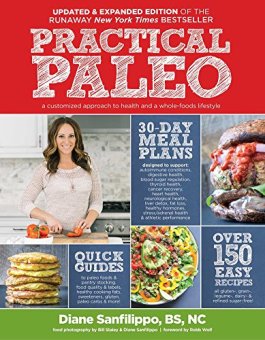
Practical Paleo, 2nd Edition – Diane Sanfilippo BS NC
(Buy from Amazon; Buy from The Book Depository)
With more than half a million copies sold, the first edition of Practical Paleo revolutionized the way we think about food and our bodies. Dubbed “The Paleo Bible” by readers, it explained how simply eating real, whole foods and avoiding processed, refined foods can improve our health—including reducing or even eliminating symptoms associated with common health disorders.
Now, this second edition has been updated to include new information, answer common questions, and make it even easier for you to customize your diet to meet your personal health goals.
What’s new?
TWO ENTIRELY NEW CHAPTERS
• “Getting Started with Paleo” shows you step by step how to switch to the Paleo way of eating, whether you want to go all-in all at once or transition gradually over time. This chapter also includes a a more comprehensive explanation of the 4R Protocol, which walks you through removing harmful foods, repairing the gut, reinoculating with beneficial bacterial, and reintroducing foods that were previously eliminated.
• “Living the Paleo Lifestyle” offers tips and suggestions for navigating holidays and parties, talking to friends and family about Paleo, getting your kids involved in the kitchen, and much more.
3 NEW 30-DAY MEAL PLANS
• The new meal plans provide guidance for addressing common health concerns: Adrenal Health (stress management), Healthy Hormones (for both women and men), and Liver Detox Support.
• There’s also a new detailed guide to finding the meal plan that’s right for you, so you can get the health benefits you need with the fewest restrictions.
40+ NEW RECIPES!
• These brand-new, mouthwatering recipes range from breakfast foods to family-friendly weeknight meals—many of which are one-pot or meal-in-one and use budget-friendly proteins.
• Recipes from the last edition have been updated based upon reader feedback over the years
• There’s also a new guide to special ingredients and where to find them
Plus, additions throughout the book explore new topics, such as when eating low-carb can actually be a problem, how stress affects the adrenal system, and why the government changed its mind about dietary cholesterol. And the organization has been extensively revised to make the valuable information on food and how it affects the body more user-friendly—and easier to apply to your own health needs.
Practical Paleo has proven to be the resource people reach for again and again for information on healthy living, delicious recipes, and guidance on changing your diet to improve your health.
Disclaimer: This page contains affiliate links that may provide monetary compensation to help support the Whole Guidance Vision of Creating a Happy and Healthy Planet should you make a purchase. We very much appreciate and thank you for your support.
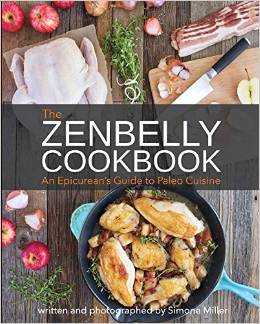
The Zenbelly Cookbook – Simone Miller
(Buy from Amazon; Buy from The Book Depository)
The Zenbelly Cookbook bridges the gap between the Paleo template and gourmet cuisine.
With a focus on quality ingredients, technique, and balancing flavors, this book will take the reader on a journey that will leave any feeling of restriction behind. With over 100 real food recipes, The Zenbelly Cookbook covers every course and occasion; from simple weeknight meals that can be made for the family in under 30 minutes, to elegant multiple course dinners that will impress any guest. The Zenbelly Cookbook will also offer entertainment tips such as: what can be made ahead, shortcuts that don’t sacrifice quality, and menu suggestions. The goal of The Zenbelly Cookbook is to make incredible, professional quality food accessible to the home cook. Each recipe has a beautiful image of the ingredients laid out, which helps the reader easily see the “before and after”. Written with the novice home cook in mind, it includes foolproof instructions. However, the flavor combinations and creativity of the book make it a great choice for the more seasoned cook, as well.
Disclaimer: This page contains affiliate links that may provide monetary compensation to help support the Whole Guidance Vision of Creating a Happy and Healthy Planet should you make a purchase. We very much appreciate and thank you for your support.
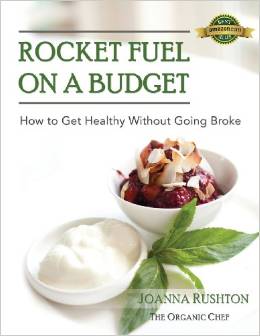
Rocket Fuel on a Budget – Joanna Rushton
(Buy from Amazon; Buy from The Book Depository)
This AMAZON #1 BEST SELLING pocket rocket book is packed with nutritional guidance, recipes and achievable goals for transforming the health of the entire family Would you like to have more energy and mental clarity and just feel fantastic every day for the rest of your life? Rocket Fuel on a Budget – How to get healthy Without going Broke will provide you with: Knowledge of the food myths of modern day nutritional recommendations A 21 day meal plan with recipes to get you started eating right immediately Education on the top 16 mistakes people make when trying to get healthy and how to avoid them Top 12 ways of sourcing affordable organic food in your local community 31 achievable tips for lasting health and vitality In Rocket Fuel On A Budget Joanna Rushton shares how to LOOK and FEEL fantastic while eating organically on a budget. If you suffer from; * Low energy levels * Moods swings and/or mental fogginess * Poor sleep * Digestive problems such as bloating or irregular bowel movements? or the yo-yo effects of dieting and trying to achieve your optimal weight? Then this is the book for you.
Disclaimer: This page contains affiliate links that may provide monetary compensation to help support the Whole Guidance Vision of Creating a Happy and Healthy Planet should you make a purchase. We very much appreciate and thank you for your support.
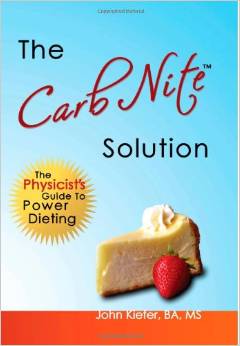
The Carb Nite Solution – John Kiefer BA MS
(visit product page; Buy from Amazon)
Trained as a physicist to rely only on concrete, verifiable research, John Kiefer has spent over a decade trying to discover a way to shed those unwanted pounds. This small volume explains his discovery and presents the research to back it up. To insure success, Kiefer not only provides arguments, answers and explanations, but he searched through food databases to assemble extensive food lists, created balanced meal plans for every lifestyle and provides over 50 fabulous recipes accessible to chefs of all caliber. Graphs, charts and tables round out this rigorous but delightful guide to successful fat loss. Whether read cover to cover or used as a prized reference, The Carb Nite Solution is the key for dieting freedom.
Disclaimer: This page contains affiliate links that may provide monetary compensation to help support the Whole Guidance Vision of Creating a Happy and Healthy Planet should you make a purchase. We very much appreciate and thank you for your support.
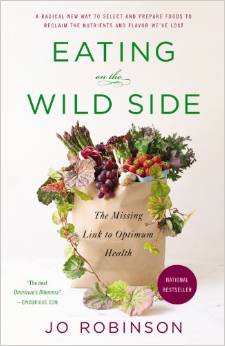
Eating on the Wild Side – Jo Robinson
(Buy from Amazon; Buy from The Book Depository)
The next stage in the food revolution–a radical way to select fruits and vegetables and reclaim the flavor and nutrients we’ve lost.
Ever since farmers first planted seeds 10,000 years ago, humans have been destroying the nutritional value of their fruits and vegetables. Unwittingly, we’ve been selecting plants that are high in starch and sugar and low in vitamins, minerals, fiber, and antioxidants for more than 400 generations.
EATING ON THE WILD SIDE reveals the solution–choosing modern varieties that approach the nutritional content of wild plants but that also please the modern palate. Jo Robinson explains that many of these newly identified varieties can be found in supermarkets and farmer’s market, and introduces simple, scientifically proven methods of preparation that enhance their flavor and nutrition. Based on years of scientific research and filled with food history and practical advice, EATING ON THE WILD SIDE will forever change the way we think about food.
Disclaimer: This page contains affiliate links that may provide monetary compensation to help support the Whole Guidance Vision of Creating a Happy and Healthy Planet should you make a purchase. We very much appreciate and thank you for your support.
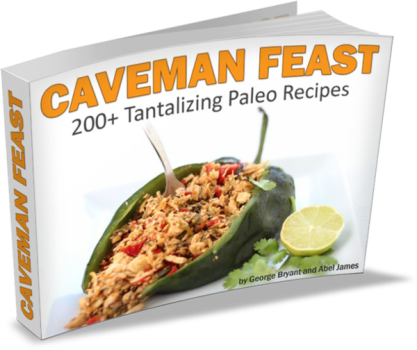
Caveman Feast – George Bryant, Abel James
(visit product page)
You get 200+ simple and easy Paleo recipes sorted into 8 categories.
Paleo recipes under the following categories will excite your taste buds and have you cooking easy but delicious meals in no time:
- Beef Entrees
- Pork Entrees
- Poultry Entrees
- Seafood Entrees
- Breakfast
- Sides
- Condiments, Sauces, Butters, Dressings, Rubs, & Blends
- Grain‐Free Goodies
Every single recipe is 100% Paleo. They have:
- No Grains
- No Potatoes
- No Lentils
- No Dairy
- No Processed Sugars
- No Preservatives
Nothing but 100% real, fresh, simple ingredients. Our goal is to make every one of your meals as delicious as possible.
Disclaimer: This page contains affiliate links that may provide monetary compensation to help support the Whole Guidance Vision of Creating a Happy and Healthy Planet should you make a purchase. We very much appreciate and thank you for your support.
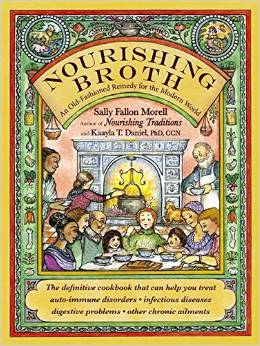
Nourishing Broth – Sally Fallon Morell, Kaayla T. Daniel PhD CCN
(Buy from Amazon; Buy from The Book Depository)
The follow-up book to the hugely best-selling Nourishing Traditions, which has sold over 500,000 copies, this time focusing on the immense health benefits of bone broth by the founder of the popular Weston A Price Foundation.
NOURISHING BROTH: An Old-Fashioned Remedy for the Modern World
Nourishing Traditions examines where the modern food industry has hurt our nutrition and health through over-processed foods and fears of animal fats. NOURISHING BROTH will continue the look at the culinary practices of our ancestors, and it will explain the immense health benefits of homemade bone broth due to the gelatin and collagen that is present in real bone broth (vs. broth made from powders).
NOURISHING BROTH will explore the science behind broth’s unique combination of amino acids, minerals and cartilage compounds. Some of the benefits of such broth are: quick recovery from illness and surgery, the healing of pain and inflammation, increased energy from better digestion, lessening of allergies, recovery from Crohn’s disease and a lessening of eating disorders because the fully balanced nutritional program lessens the cravings which make most diets fail. Diseases that bone broth can help heal are: Osteoarthritis, Osteoporosis, Psoriasis, Infectious Disease, digestive disorders, even Cancer, and it can help our skin and bones stay young.
In addition, the book will serve as a handbook for various techniques for making broths-from simple chicken broth to rich, clear consommé, to shrimp shell stock. A variety of interesting stock-based recipes for breakfast, lunch and dinner from throughout the world will complete the collection and help everyone get more nutrition in their diet.
Disclaimer: This page contains affiliate links that may provide monetary compensation to help support the Whole Guidance Vision of Creating a Happy and Healthy Planet should you make a purchase. We very much appreciate and thank you for your support.
